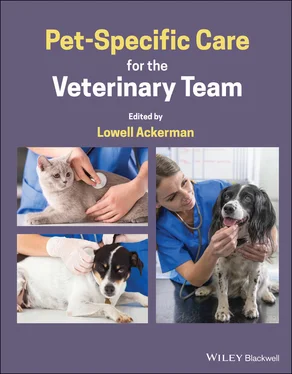Mixed‐breed pets have always posed a problem to disease risk prediction, since without knowing breeds, it can be difficult to predict breed predisposition to disease (see 3.19Mixed‐Breed Considerations). This has been partially offset today by the ability to determine likely breed contributions on the basis of genetic testing. Such genetic testing will often not determine ancestry with absolute precision, but perhaps with sufficient accuracy to allow veterinary teams to consider some disease predisposition in individuals. Genetic testing can also be used for disease screening of certain entities, and may even predict a variety of traits, such as the pet's likely size as an adult.
Since medical records are also legal documents, if a mixed‐breed animal is presented, it is best to identify it as a mixed‐breed in the breed field within practice management software. Identifying pets as crosses based on their appearance (e.g., shepherd x, Himalayan x) is fraught with inaccuracies and likely gets things wrong as often as gets them right. Since the breed identified in a medical record can be a clue to disease predisposition, it is better not to try to “guess” what the contributing breeds might be and instead either use a generic term like mixed‐breed or use genetic testing to get a better approximation, if desired. The only time more specific speculation is warranted is if the parents of the mixed‐breed animal are known with certainty (e.g., neighbor's dog jumped the fence and impregnated pet owner's intact bitch).
While purebreds and hybrids tend to have higher relative risk for certain genetic disorders (especially traits attributable to single‐gene mutations), it is important to realize that mixed‐breed animals may still constitute a significant proportion of health concerns in a practice (e.g., diabetes mellitus, osteoarthritis, obesity, etc.).
There is a tendency to recommend mixed‐breed pets to prospective owners based on the fact that there are many more of these available in shelters that need homes, and this is a very real benefit, but it is also important to realize that there are many reasons why some prefer to bring purebreds and hybrids into their homes.
 TAKE‐AWAYS
TAKE‐AWAYS
Purebred animals tend to be at highest relative risk for genetic diseases, especially those attributable to disease variants associated with single‐gene mutations (e.g., progressive retinal atrophy).
In many practices, the proportion of purebreds and hybrids is roughly equivalent to the number of mixed‐breed animals.
Tracking correct breed information in practice management software is critically important and then using that information to create patient risk profiles.
Mixed‐breed animals may have lower risks for certain genetic diseases, but this can be somewhat offset by the fact that their actual disease risks are harder to predict.
Owners often purchase purebreds and hybrids based on real or imagined benefits, but predictability of traits, behaviors, and even health risks is a real advantage.
 MISCELLANEOUS
MISCELLANEOUS
Recommended Reading
1 Ackerman, L. (2011). The Genetic Connection. Lakewood, CO: AAHAPress.
2 Ackerman, L. (2020). Proactive Pet Parenting: Anticipating pet health problems before they happen. Problem Free Publishing.
3 Gough, A., Thomas, A., and O'Neill, D. (2018). Breed Predispositions to Disease in Dogs and Cats, 3e. Ames, IA: Wiley Blackwell.
3.10 Advising Clients on Selecting an Appropriate Pet
Lowell Ackerman, DVM, DACVD, MBA, MPA, CVA, MRCVS
Global Consultant, Author, and Lecturer, MA, USA
 BASICS
BASICS
3.10.1 Summary
Many clients acquire a pet without a good understanding of its long‐term healthcare needs. Accordingly, this lack of understanding translates both to poor compliance/adherence and to improper planning for a lifetime of healthcare.
Veterinary teams would be well served to spend time with clients, understanding their needs and concerns, explaining in advance what the likely healthcare process will be, including expenses to be anticipated along the way and when changes in healthcare requirements will likely occur.
Adherence:The extent to which patients take medications as prescribed, which involves the pet owner in filling and refilling the prescription, administering the correct dose, timing and use, and completing the prescribed course.
Advocate:Someone who speaks or takes action on behalf of another.
Compliance:The extent to which pets receive a treatment, screening, or procedure in accordance with recommended veterinary healthcare practices.
Pet‐specific Care:An approach that tailors veterinary care to individual pets based on their predicted risk of disease and likely response to intervention
 MAIN CONCEPTS
MAIN CONCEPTS
3.10.3 Acquiring a Pet
Most veterinary teams play little or no role in the acquisition of a pet, so clients often begin and complete this process without appropriate healthcare advice (see 5.6Adoption Source Options). Veterinary staff might be amused when clients come in with a “purebred cockapoo” that they purchased for a considerable sum (with papers?) and evidence of ear mites, luxating patellas, and an umbilical hernia, but most would‐be pet owners have no idea how to do a better job with the process. Interestingly, these new pet owners rarely price‐shop for their new pets – they typically pay in full at time of acquisition, and they often make the purchase on impulse.
In a much better process, veterinarians or trained staff could interview would‐be pet owners and help them select an animal that would best fit their lifestyle ( Table 3.10.1), and then counsel them on where they might find suitable animals, health guarantees that should be requested, and terms that include a no‐questions‐asked money‐back guarantee following veterinary examination [1]. Veterinarians could even provide adoption questionnaires that inquire about health issues in the animals or their parents, and genetic testing that might have been done to mitigate healthcare risks ( Table 3.10.2). Recommended tests to consider on a breed basis are available for both dogs ( www.ofa.org/browse‐by‐breed) and cats ( https://icatcare.org/advice/cat‐breeds), and breed predisposition information is available (see 11.4Heritable Health Conditions – By Breed).
Table 3.10.1 A sample of dog and cat breed selector tools found on the internet
| Organization |
Website |
| Animal Planet (dog) |
www.animalplanet.com/breed‐selector/dog‐breeds.html |
| Animal Planet (cat) |
www.animalplanet.com/breedselector/catselectorindex.do |
| American Kennel Club (dog) |
www.akc.org/dog‐breed‐selector |
| DogTime (dog) |
http://dogtime.com/quiz/dog‐breed‐selector |
| Hills (cat) |
www.hillspet.com/cat‐care/new‐pet‐parent/choosing‐right‐cat‐breeds |
| Iams |
www.iams.com/breedselector |
| Optimum Pet (cat) |
www.optimumpet.com.au/cat‐advice/cat‐selector |
| Pedigree (dog) |
www.pedigree.com/getting‐a‐new‐dog/breed‐match |
| Puppyfinder (dog) |
www.puppyfinder.com/dog‐breed‐selector |
| Purina (dog) |
www.purina.com/dogs/dog‐breeds/dog‐breed‐selector |
| Purina (cat) |
www.purina.com/cat‐breed‐selector |
| Select a Dog Breed |
www.selectadogbreed.com |
| Select Smart (dog) |
www.selectsmart.com/dog |
| Select Smart (cat) |
http://selectsmart.com/CAT |
| Vetstreet |
www.vetstreet.com/breed‐finder |
| Whiskas (cat) |
www.whiskas.co.uk/breed‐selector |
Table 3.10.2 Golden retriever adoption questionnaire
Читать дальше

 TAKE‐AWAYS
TAKE‐AWAYS MISCELLANEOUS
MISCELLANEOUS BASICS
BASICS MAIN CONCEPTS
MAIN CONCEPTS










